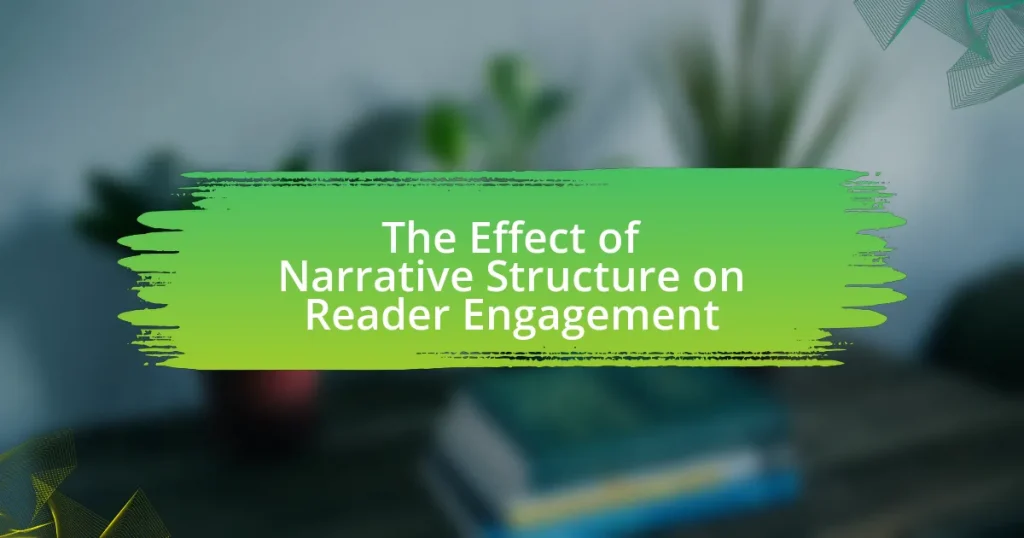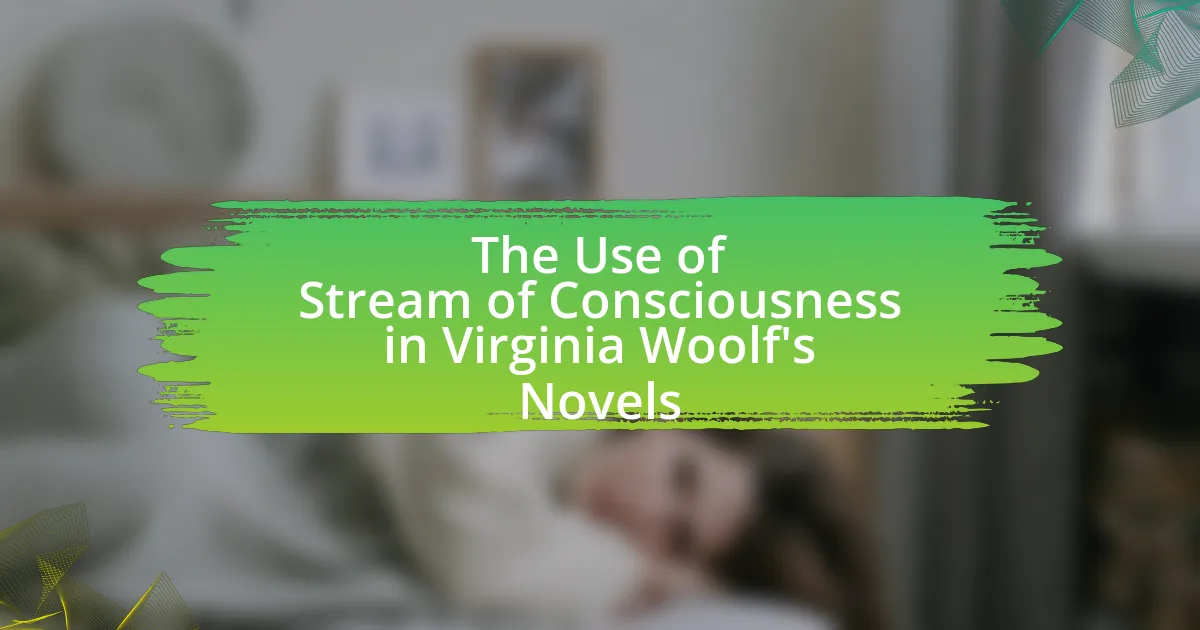The article examines the effect of narrative structure on reader engagement, highlighting how different arrangements of plot, character development, and pacing influence emotional investment and comprehension. It discusses various narrative techniques, such as linear and non-linear structures, and their impact on reader perception and retention. Key elements like conflict, theme, and character arcs are analyzed for their roles in enhancing engagement, while psychological theories, such as Transportation Theory, are referenced to explain the relationship between narrative structure and reader involvement. The article also addresses common pitfalls in narrative construction that can lead to disengagement, emphasizing the importance of clarity and coherence in storytelling.
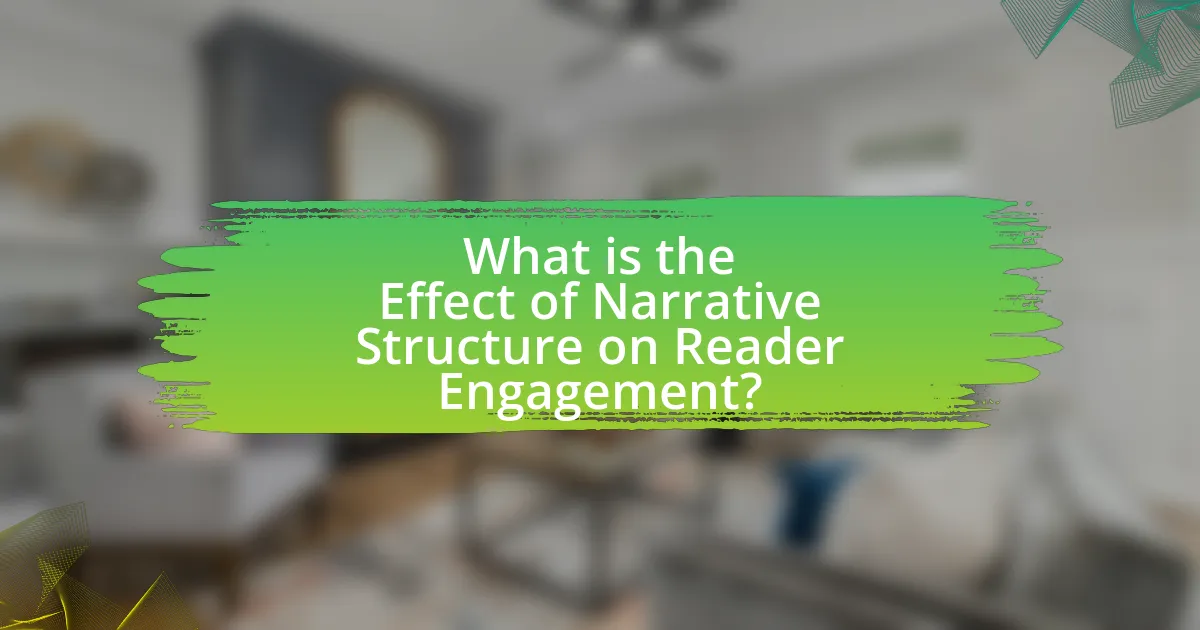
What is the Effect of Narrative Structure on Reader Engagement?
Narrative structure significantly influences reader engagement by shaping how a story is perceived and experienced. A well-crafted narrative structure, such as the use of a nonlinear timeline or multiple perspectives, can enhance suspense and emotional investment, leading to deeper reader involvement. Research indicates that stories with a clear beginning, middle, and end, as well as those that employ techniques like foreshadowing and cliffhangers, tend to maintain reader interest more effectively. For instance, a study published in the journal “Psychological Science” by transportation theory researchers found that readers who felt transported into a narrative were more likely to engage with the material and retain information. This demonstrates that the arrangement of narrative elements directly correlates with the level of engagement experienced by readers.
How does narrative structure influence the way readers connect with a story?
Narrative structure significantly influences how readers connect with a story by shaping their emotional engagement and comprehension. A well-defined structure, such as the classic three-act format, guides readers through the plot, allowing them to anticipate developments and invest emotionally in characters’ journeys. For instance, studies show that stories with clear beginnings, middles, and ends enhance reader satisfaction and retention of information, as they create a coherent framework that facilitates understanding. Additionally, nonlinear narratives can evoke curiosity and deeper analysis, prompting readers to piece together the storyline, which can lead to a more profound connection with the material. Thus, the arrangement of events and the pacing of revelations directly affect the reader’s emotional and cognitive engagement with the story.
What are the key elements of narrative structure that impact reader engagement?
The key elements of narrative structure that impact reader engagement include plot, character development, setting, conflict, and theme. Plot provides the framework for the story, guiding the reader through events and maintaining interest. Character development allows readers to connect emotionally with the characters, enhancing their investment in the narrative. The setting establishes the context and atmosphere, influencing the reader’s immersion. Conflict creates tension and drives the narrative forward, keeping readers eager to see how it resolves. Finally, theme conveys the underlying message or moral, prompting readers to reflect on the story’s significance. Research indicates that these elements work synergistically to enhance engagement, as evidenced by studies showing that well-structured narratives lead to higher emotional responses and retention rates among readers.
How do different narrative techniques affect emotional responses from readers?
Different narrative techniques significantly influence emotional responses from readers by shaping their engagement and connection to the story. Techniques such as first-person narration create intimacy, allowing readers to experience the protagonist’s thoughts and feelings directly, which can evoke empathy and deeper emotional investment. In contrast, third-person omniscient narration provides a broader perspective, enabling readers to understand multiple characters’ emotions, which can lead to a more complex emotional response. Additionally, the use of unreliable narrators can create tension and surprise, prompting readers to question the truth and feel a mix of emotions such as confusion or intrigue. Research by Miall and Kuiken (1994) in “Beyond the Schema: The Role of Narrative in the Construction of Meaning” demonstrates that narrative structure directly impacts emotional engagement, showing that varied techniques can elicit distinct emotional reactions based on how they manipulate reader perception and involvement in the story.
Why is understanding narrative structure important for writers?
Understanding narrative structure is crucial for writers because it shapes how a story is perceived and engages readers. A well-defined narrative structure provides a framework that guides the pacing, development of characters, and the unfolding of the plot, which directly influences reader investment and emotional response. Research indicates that stories with clear structures, such as the three-act structure, enhance comprehension and retention, making it easier for readers to connect with the material. For instance, a study published in the journal “Cognitive Science” by researchers at the University of California found that narratives with coherent structures significantly improve memory recall compared to disorganized narratives. This evidence underscores the importance of narrative structure in crafting compelling stories that resonate with audiences.
How can narrative structure enhance storytelling effectiveness?
Narrative structure enhances storytelling effectiveness by providing a framework that organizes events and character development, making the story more engaging and coherent. A well-defined structure, such as the three-act format, allows for a clear progression of tension and resolution, which keeps readers invested in the outcome. Research indicates that stories with a strong narrative structure are more memorable; for instance, a study published in the journal “Cognitive Science” by Paul Zak found that narratives that follow a structured format elicit stronger emotional responses, leading to better retention of information. This emotional engagement is crucial for reader connection and overall storytelling impact.
What role does narrative structure play in character development and plot progression?
Narrative structure significantly influences character development and plot progression by providing a framework that shapes how stories unfold and how characters evolve. A well-defined narrative structure, such as the three-act structure, guides the pacing and reveals character motivations, allowing readers to understand character arcs and their transformations over time. For instance, in classic literature, the exposition introduces characters and their conflicts, while rising action develops their complexities, leading to a climax that often serves as a turning point for character growth. This structured approach ensures that plot progression is coherent and engaging, as it aligns character decisions with narrative events, creating a sense of causality that enhances reader investment. Studies in narrative theory, such as those by M. J. M. van Dijk, highlight that a clear narrative structure not only aids in character relatability but also maintains reader engagement by creating suspense and anticipation, essential for effective storytelling.
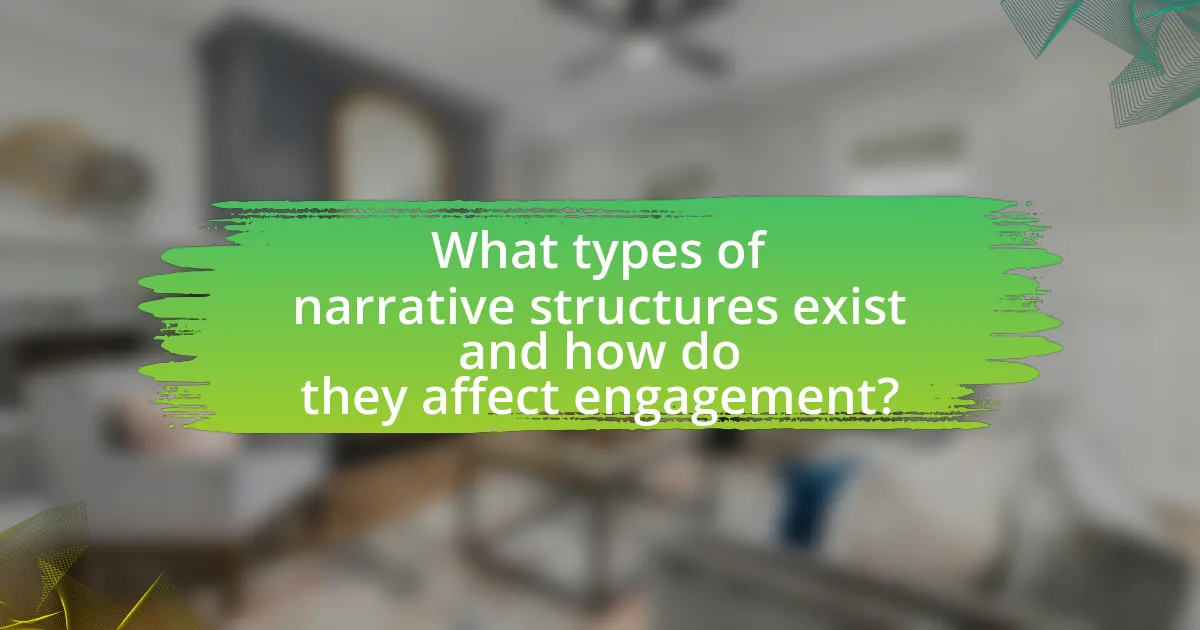
What types of narrative structures exist and how do they affect engagement?
Various types of narrative structures exist, including linear, non-linear, circular, and fragmented structures, each influencing reader engagement differently. Linear narratives follow a chronological order, which typically enhances clarity and allows readers to easily follow the plot, thereby increasing engagement. Non-linear narratives, which may include flashbacks or multiple timelines, can create suspense and intrigue, often leading to deeper emotional investment from readers. Circular narratives, where the story ends where it began, can evoke a sense of completeness and reflection, enhancing engagement through thematic resonance. Fragmented structures, which present disjointed scenes or perspectives, can challenge readers and stimulate critical thinking, potentially increasing engagement through active participation in piecing together the narrative. Research indicates that the choice of narrative structure significantly impacts emotional responses and cognitive engagement, as evidenced by studies showing that non-linear narratives can lead to higher levels of curiosity and satisfaction among readers.
What are the common narrative structures used in literature?
Common narrative structures used in literature include linear, non-linear, circular, and fragmented structures. Linear narrative structure presents events in chronological order, allowing readers to follow the story easily. Non-linear structures, such as flashbacks or parallel timelines, create complexity and can enhance engagement by challenging readers to piece together the narrative. Circular structures begin and end at the same point, often emphasizing themes or character development. Fragmented narratives present disjointed events, which can evoke curiosity and deeper analysis from readers. These structures influence reader engagement by shaping how the story is perceived and understood, as evidenced by the varying reader responses to different narrative techniques in literary studies.
How does a linear narrative structure differ from a non-linear one in terms of reader engagement?
A linear narrative structure typically enhances reader engagement by providing a clear, chronological progression of events, which allows readers to easily follow the story and develop a connection with the characters. In contrast, a non-linear narrative structure can create intrigue and challenge readers to piece together the story, often leading to a more active engagement as they work to understand the relationships between events. Research indicates that linear narratives often result in higher comprehension and emotional investment, as seen in studies where participants reported greater satisfaction with stories that followed a straightforward timeline compared to those with fragmented timelines.
What is the impact of unreliable narrators on reader perception and engagement?
Unreliable narrators significantly influence reader perception and engagement by creating ambiguity and prompting critical thinking. This narrative technique encourages readers to question the truthfulness of the narrator’s account, leading to a more active reading experience. Studies, such as those by E. M. Forster in “Aspects of the Novel,” highlight that readers become more engaged when they must decipher the underlying reality behind the narrator’s perspective. This engagement often results in deeper emotional investment and a more profound connection to the narrative, as readers navigate the complexities of truth and deception presented by the unreliable narrator.
How do cultural and genre differences influence narrative structure?
Cultural and genre differences significantly influence narrative structure by shaping the expectations and conventions that guide storytelling. For instance, Western narratives often follow a linear structure with a clear beginning, middle, and end, emphasizing character development and conflict resolution, as seen in classic novels like “Pride and Prejudice” by Jane Austen. In contrast, many Eastern narratives may employ a circular structure, focusing on themes of harmony and interconnectedness, as exemplified in works like “The Tale of Genji” by Murasaki Shikibu. Additionally, genre conventions dictate narrative elements; for example, mystery genres prioritize suspense and plot twists, while romance genres emphasize emotional arcs and character relationships. These structural variations cater to the cultural values and reader expectations inherent in different societies, thereby enhancing reader engagement through familiarity and resonance with the narrative form.
What narrative structures are prevalent in different literary genres?
Different literary genres utilize distinct narrative structures that significantly influence reader engagement. For instance, in fiction, the three-act structure is prevalent, consisting of setup, confrontation, and resolution, which helps maintain suspense and emotional investment. In contrast, poetry often employs non-linear structures, allowing for varied interpretations and emotional resonance through imagery and rhythm.
In mystery genres, the use of a fragmented narrative structure is common, where clues are revealed out of chronological order, enhancing intrigue and engagement. Conversely, in romance novels, a linear narrative structure is frequently used, focusing on character development and relationship progression, which fosters a deeper emotional connection with the reader.
These structures are not arbitrary; they are designed to align with genre conventions and reader expectations, thereby enhancing engagement. For example, research by M. J. O’Brien in “Narrative Structure and Reader Engagement” highlights that readers are more likely to remain engaged when narrative structures align with their genre preferences, confirming the importance of structure in literary genres.
How do cultural contexts shape the effectiveness of narrative structures?
Cultural contexts significantly shape the effectiveness of narrative structures by influencing how stories are interpreted and resonated with by audiences. Different cultures have unique storytelling traditions, values, and expectations that dictate narrative preferences, such as linear versus non-linear storytelling. For instance, in Western cultures, narratives often follow a clear beginning, middle, and end structure, while many Eastern cultures may embrace circular narratives that reflect cyclical views of life. This cultural variance affects reader engagement, as narratives that align with cultural norms are more likely to resonate emotionally and cognitively with the audience. Research by Joseph Campbell in “The Hero with a Thousand Faces” illustrates how universal themes in narratives can be adapted to fit specific cultural contexts, enhancing their effectiveness and relatability.
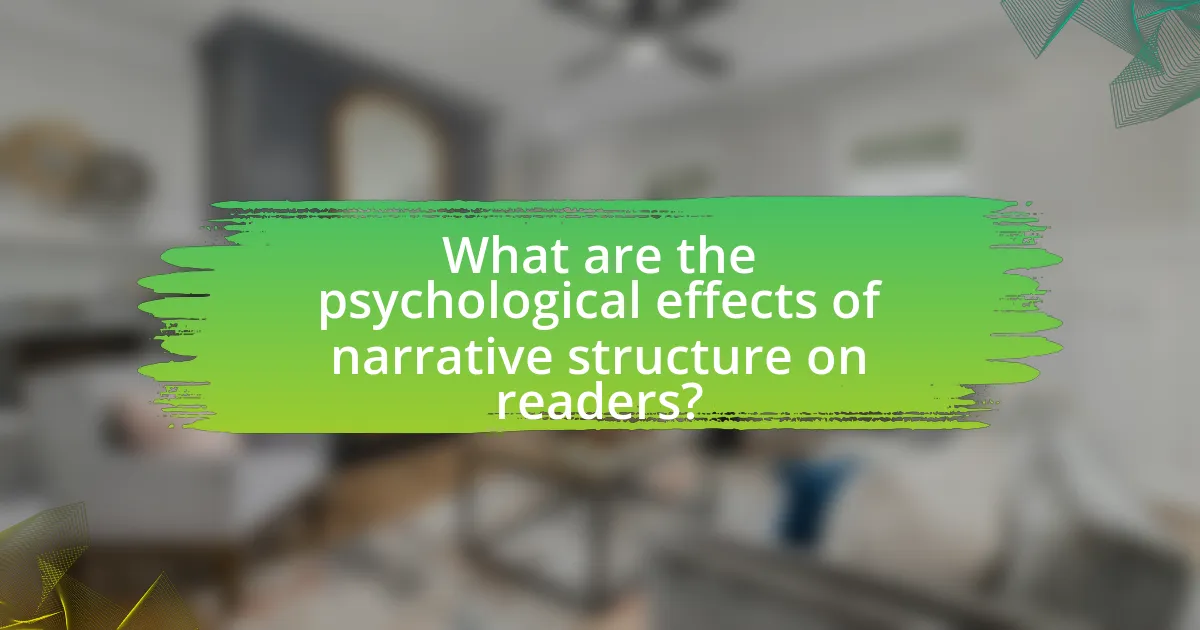
What are the psychological effects of narrative structure on readers?
The psychological effects of narrative structure on readers include enhanced emotional engagement, improved comprehension, and increased retention of information. Narrative structures, such as linear, non-linear, and circular formats, influence how readers process and relate to the story. For instance, a well-structured narrative can evoke empathy by allowing readers to connect with characters’ experiences, as demonstrated in studies showing that readers often mirror the emotions of characters, leading to a deeper emotional response. Additionally, research indicates that narratives with clear structures facilitate better understanding and memory recall, as they provide a framework that helps readers organize information effectively. This is supported by findings from the Journal of Educational Psychology, which highlight that structured narratives significantly improve retention rates compared to unstructured texts.
How does narrative structure affect cognitive processing in readers?
Narrative structure significantly influences cognitive processing in readers by shaping how they interpret and engage with the text. A well-organized narrative, such as those following a chronological or thematic structure, facilitates easier comprehension and retention of information, as it aligns with the brain’s natural tendency to seek patterns and coherence. Research by M. J. Oatley and D. K. G. Johnson in “The Role of Narrative in Human Experience” indicates that narratives structured with clear beginnings, middles, and ends enhance memory recall by providing a framework that readers can mentally map onto their own experiences. This structured approach allows readers to better predict outcomes and understand character motivations, ultimately leading to deeper emotional engagement and cognitive processing.
What psychological theories explain the relationship between narrative structure and reader engagement?
Psychological theories that explain the relationship between narrative structure and reader engagement include the Transportation Theory and the Narrative Paradigm. Transportation Theory posits that when readers become immersed in a story, they experience a psychological state of transportation, which enhances emotional engagement and retention of information. Research by Green and Brock (2000) supports this, indicating that narrative structure, particularly the coherence and emotional resonance of the plot, significantly influences the degree of transportation experienced by readers.
Additionally, the Narrative Paradigm, proposed by Walter Fisher, suggests that humans are natural storytellers and that narratives are a primary means of understanding and interpreting experiences. This theory emphasizes that the structure of a narrative—its characters, plot, and themes—affects how relatable and engaging the story is, thereby impacting reader engagement. Studies have shown that well-structured narratives that align with readers’ values and beliefs foster deeper connections and engagement.
Together, these theories illustrate that effective narrative structures enhance reader engagement by facilitating emotional connection and cognitive involvement.
How does suspense and pacing within narrative structure impact reader retention?
Suspense and pacing within narrative structure significantly enhance reader retention by maintaining engagement and creating emotional investment. When a narrative effectively builds suspense, it compels readers to continue reading to resolve uncertainty, as evidenced by studies showing that stories with cliffhangers or unresolved conflicts lead to higher retention rates. Additionally, optimal pacing—balancing action with slower, reflective moments—ensures that readers remain interested without feeling overwhelmed or bored. Research indicates that narratives with varied pacing keep readers more engaged, as they can anticipate and react to shifts in tension, thereby increasing their likelihood of remembering the story.
What strategies can writers use to enhance reader engagement through narrative structure?
Writers can enhance reader engagement through narrative structure by employing techniques such as non-linear storytelling, cliffhangers, and character-driven plots. Non-linear storytelling captivates readers by presenting events out of chronological order, which can create suspense and encourage deeper analysis of the narrative. For example, the novel “Catch-22” by Joseph Heller uses a non-linear structure to reflect the chaotic nature of war, keeping readers intrigued.
Cliffhangers at the end of chapters compel readers to continue, as they create a sense of urgency and anticipation. This technique is effectively utilized in series like “Game of Thrones” by George R.R. Martin, where each chapter often ends with a shocking twist, prompting readers to turn the page.
Character-driven plots enhance engagement by allowing readers to form emotional connections with characters, making their journeys more relatable and impactful. In “The Great Gatsby,” F. Scott Fitzgerald’s focus on Gatsby’s aspirations and struggles invites readers to invest emotionally in his story. These strategies collectively foster a more immersive reading experience, thereby increasing reader engagement.
How can writers effectively utilize foreshadowing and flashbacks in their narratives?
Writers can effectively utilize foreshadowing and flashbacks by strategically placing hints and past events within their narratives to enhance suspense and deepen character development. Foreshadowing creates anticipation by subtly indicating future events, which keeps readers engaged and encourages them to make predictions. For example, in literature, a character’s seemingly innocuous remark may later reveal critical plot twists, as seen in works like “The Great Gatsby,” where early references to the green light foreshadow Gatsby’s unattainable dreams.
Flashbacks, on the other hand, provide context and background, allowing readers to understand characters’ motivations and the significance of current events. This technique can be observed in “To Kill a Mockingbird,” where flashbacks reveal Scout’s childhood experiences, enriching the narrative and fostering empathy. Both techniques, when used effectively, not only maintain reader interest but also create a more layered and immersive storytelling experience.
What are best practices for balancing complexity and clarity in narrative structure?
Best practices for balancing complexity and clarity in narrative structure include using a clear central theme, maintaining a logical progression of events, and employing varied sentence structures. A clear central theme helps readers understand the core message, while a logical progression ensures that the narrative flows smoothly, preventing confusion. Varied sentence structures can enhance engagement by maintaining reader interest without overwhelming them with complexity. Research indicates that narratives with a well-defined structure and clear thematic elements are more likely to retain reader attention, as evidenced by studies on reader comprehension and engagement metrics.
What are common pitfalls to avoid in narrative structure for better reader engagement?
Common pitfalls to avoid in narrative structure for better reader engagement include lack of clear conflict, weak character development, and poor pacing. A narrative without clear conflict fails to create tension, which is essential for keeping readers invested; studies show that stories with strong conflicts are more engaging. Weak character development leads to a lack of emotional connection, as readers are less likely to care about characters they do not understand or relate to; research indicates that well-developed characters enhance reader empathy. Lastly, poor pacing disrupts the flow of the story, causing readers to lose interest; effective pacing maintains suspense and keeps readers turning pages.
How can overcomplicated narrative structures detract from reader experience?
Overcomplicated narrative structures can detract from reader experience by creating confusion and hindering comprehension. When narratives are excessively intricate, readers may struggle to follow the plot, leading to frustration and disengagement. Research indicates that clarity in storytelling enhances reader enjoyment and retention; for instance, a study published in the Journal of Experimental Psychology found that simpler narrative structures improve understanding and emotional connection to the story. Therefore, when narratives become convoluted, they risk alienating readers and diminishing their overall engagement with the text.
What are the signs of a poorly structured narrative that can disengage readers?
Signs of a poorly structured narrative that can disengage readers include a lack of clear plot progression, inconsistent character development, and weak thematic coherence. When a narrative lacks a clear plot progression, readers may struggle to follow the story, leading to confusion and disinterest. Inconsistent character development can result in characters that feel flat or unrelatable, making it difficult for readers to invest emotionally. Additionally, weak thematic coherence can leave readers feeling unsatisfied, as they may not grasp the underlying messages or significance of the narrative. These elements collectively contribute to a disengaging reading experience, as supported by narrative theory which emphasizes the importance of structure in maintaining reader interest.
